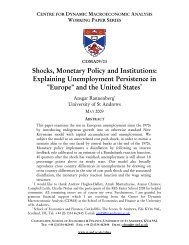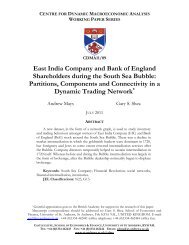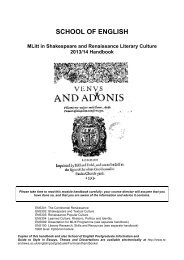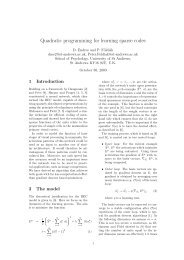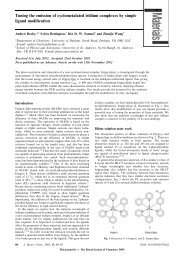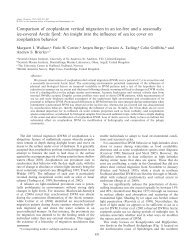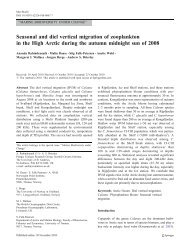Exchange rate dynamics, asset market structure and the role of the ...
Exchange rate dynamics, asset market structure and the role of the ...
Exchange rate dynamics, asset market structure and the role of the ...
You also want an ePaper? Increase the reach of your titles
YUMPU automatically turns print PDFs into web optimized ePapers that Google loves.
<strong>structure</strong> in <strong>the</strong> model is relatively st<strong>and</strong>ard in <strong>the</strong> literature. Home <strong>and</strong> foreign agents can<br />
trade in one non-contingent bond, B t that pays out one unit <strong>of</strong> home-produced intermediate<br />
goods in period t + 1. I denote by B t <strong>the</strong> quantity <strong>and</strong> by R t <strong>the</strong> price <strong>of</strong> <strong>the</strong> bond purchased<br />
by home agents at <strong>the</strong> end <strong>of</strong> period t:The representative consumer faces <strong>the</strong> following budget<br />
constraint in each period t:<br />
P t C t + P H;t R t B t = P H;t B t 1 + P t w t h t + t (4)<br />
where P t is <strong>the</strong> price index <strong>of</strong> <strong>the</strong> consumption bundle, de…ned below, P H;t is <strong>the</strong> price<br />
<strong>of</strong> home produced intermediate goods <strong>and</strong> w t is <strong>the</strong> real wage. In addition to <strong>the</strong> wage,<br />
<strong>the</strong> representative household receives dividends, t , from holding a share in <strong>the</strong> equity <strong>of</strong><br />
domestic …rms. All domestic …rms are wholly owned by domestic agents <strong>and</strong> equity holding<br />
within <strong>the</strong>se …rms is evenly divided between domestic households. When optimising, <strong>the</strong><br />
representative household takes <strong>the</strong> ‡ow <strong>of</strong> dividends as given.<br />
The maximization problem <strong>of</strong> <strong>the</strong> Home representative agent consists <strong>of</strong> maximizing (1)<br />
subject to (4), along with <strong>the</strong> usual transversality condition:<br />
lim<br />
T !1 E t<br />
TY<br />
R s B t+T = 0 (5)<br />
s=1<br />
in determining <strong>the</strong> optimal pro…le <strong>of</strong> consumption <strong>and</strong> bond holding <strong>and</strong> <strong>the</strong> labour supply<br />
schedule. The corresponding Lagrange multiplier is:<br />
max<br />
C t;h t;B t; t<br />
L = E t<br />
1<br />
X<br />
s=t<br />
s<br />
<br />
U(C s ; (1<br />
<br />
PH;s<br />
h s )) + s B s 1 + w s h s + <br />
s P H;s<br />
C s R s B s<br />
P s P s<br />
Using …rst order conditions for optimal consumption, labour e¤ort <strong>and</strong> bond holdings one<br />
can derive <strong>the</strong> static e¢ ciency condition for <strong>the</strong> consumption-labour choice as well as <strong>the</strong><br />
consumption Euler equation:<br />
U C (C t ; (1<br />
h t )) P H;t<br />
P t<br />
P s<br />
(6)<br />
U h (C t ; (1 h t ))<br />
U C (C t ; (1 h t )) = w t (7)<br />
= ( ~ C t ; ~ h t ) 1 R t<br />
E t<br />
<br />
U C (C t+1 ; (1<br />
h t+1 )) P H;t+1<br />
P t+1<br />
In equilibrium, <strong>the</strong> household <strong>and</strong> average per capita levels <strong>of</strong> consumption <strong>and</strong> e¤ort are<br />
<br />
(8)<br />
6



